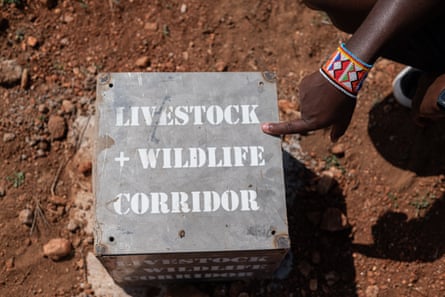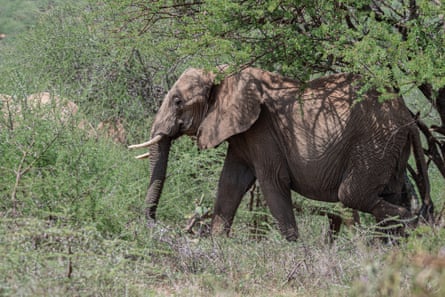PROTECT YOUR DNA WITH QUANTUM TECHNOLOGY
Orgo-Life the new way to the future Advertising by AdpathwayAt nearly 3.5-metres tall and weighing as much as a bus, you could be forgiven for assuming that Goshi – one of an estimated 30 “super-tusker” elephants left in Africa – would be easy to find. The radio tracker picking up his signal beeps encouragingly, indicating the giant bull is within 200 metres. But the dry season has turned the mass of arid acacia scrubland grey, and everything seems to resemble an elephant.
Even when they are invisible, the huge herbivores shape the landscape here. There are 17,000 elephants across the Tsavo region, Kenya’s largest protected area, which is divided in two. Each year, elephants wander huge distances between feeding grounds, following the seasonal rains as they have done for thousands of years.
But the thicket where Goshi and his accompanying group of male elephants are hiding is a frontier of rapidly changing habitat. Two lines of pylons pass through the land next to the Mombasa-Nairobi highway, where lorries roar past night and day. About 100 metres away, the Chinese-built SGR railway bisects the Tsavo area.

Some of the elephants will brave the railway’s underpasses – but others are scared off by the traffic and noise. During seasonal migrations, hundreds gather at bottlenecks and blocked routes. Conservationists fear a proposed four-lane extension to the Mombasa-Nairobi highway could cut off their migration routes for ever.
Electric fences, new roads, railway lines and growing human settlements are cross-hatching the elephant passages, blocking their way, fragmenting access to food and water, and putting them in competition with people for resources.
While there are no definitive figures for the scale of the problem, researchers say it is a pattern happening across elephant rangelands in Africa as the continent develops. Northern Kenya is one of the few places with figures, which show that human-elephant conflict has overtaken poaching as the main threat to the mammals in recent years. For people and elephants, those clashes are proving deadly.
Sarolie Louwapere did not see the bull elephant until it was too late. It was a normal August morning in Oldonyiro, an isolated settlement in northern Kenya, and the 19-year-old was taking his family’s herd of goats to graze underneath the acacia trees. Their brown seedpods, scattered over the red soils where the semi-nomadic Samburu people make their home, are a favourite with goats and elephants. After shaking the canopy to bring more pods down, the teenager spotted the elephant just metres away. It charged, knocking him to the floor.
“The bull elephant hit him on the side. It broke Sarolie’s leg. Luckily, he fell into a gully so it didn’t come back to trample him,” says Ntoimar Louwapere, Sarolie’s father, a village elder in his early 50s. His son is now receiving treatment away from home.

“It has changed how I think of elephants,” he says, sitting on a wooden chair outside his house. “Anything can happen with them. They can kill. But there’s nothing I can do, because we live together.”
Across sub-Saharan Africa, there has been a sharp rise in deaths linked to human-elephant conflict. While the exact figures are unclear, dozens of people are believed to have been killed and injured across elephant ranges, sparking an increase in retaliatory killings of the animals.
China’s ban on the ivory trade within the country from 2018 led to the ivory price plunging and a marked drop in poaching for elephants’ tusks. In 2011, when poaching peaked, more than 30,000 elephants were being killed every year in Africa for their ivory, which was transformed into piano keys, ornaments and used in traditional medicine.

Scientists estimate less than half that number are killed by poachers today. About 415,000 African elephants are left in the wild, with both African species now classified as at risk of extinction after population collapses in recent decades. African forest elephant numbers have fallen by 86% in three decades.
Oldonyiro, home to about 3,000 people, sits at the heart of a key passage for hundreds of African savannah elephants in northern Kenya. Enclosed by steep hills on either side, the animals pass through a small corridor in the hills as they travel between seasonal feeding grounds. In April and May, they move in search of water and fresh greenery brought by the rains. Six months later, they move back.
Today, the primary school, church and dozens of traditional Samburu bomas – circular enclosures where people live with their livestock to defend them from hyenas and leopards – are just metres from the migration routes. Piles of elephant dung cover the ground near where children play. Sometimes, groups of 50 elephants pass by, local people say.

“They are threatening our lives,” says the Rev Sammy Letapi. “Even early in the morning, elephants are standing here. We are scared of them … Recently, we had a case of someone who was killed in this corridor, just over there.”
When the animals pass by the settlement, they often do so at night or early in the morning – moving silently through the landscape to the waterhole on the other side of town. Conservation organisations are working with local people to keep the migration routes open, asking them not to build their homes in the middle of the elephants’ route.
But Letapi wants an electric fence to guarantee separation. “We just want to be able to carry out our tasks. We are used to living with animals; we love elephants. We do care – if we didn’t, we would have killed them,” he says.
When the rains arrive, Tsavo communities race to grow maize, lentils, sesame and other staples to feed their families over the year ahead. But now, Goshi and other elephants have such a taste for their crops that people sleep in makeshift shelters throughout the three-month rainy season to prevent the raids.
“There are many of them. They move around looking for something to eat. You can see where they have rooted out my cassava over there [pointing to a hole in the ground near his home]. There were five of them. They were very big boys,” says Richard Shika, a 68-year-old farmer.

“Three years ago, I was coming back from my washroom and one was here eating my maize. I started throwing rocks at it and it came at me,” he says.
But in the area, people are learning to adapt to the raiders. Shika’s fields, like those of many of his neighbours, are surrounded by beehive fencing – a series of honeybee hives strung between posts – to scare off elephants.

Dr Lucy King, a researcher with Save the Elephants, used the animals’ natural fear of the insects to promote the use of bee fencing to reduce clashes. The bees also help farmers by pollinating crops and they make money from selling the honey. Over the years, the discovery has joined a catalogue of techniques farmers use to defend their crops: chilli balls, ditches, night watchmen and bangers are all deployed to keep the elephants away.
One 2024 study found that beehive fencing can reduce up to 86% of crop raids during peak season if there are good rains. But the insects are sensitive to drought and were much less effective in periods of unpredictable weather.
Mwanajuma Kibula, Shika’s neighbour, says the methods have helped maintain an uneasy peace with the animals. In a few weeks, when the rain returns, the 54-year-old and her family will spend the nights outside once again, keeping watch for hungry raiders.
“When the rains come, we will not sleep at night,” she says. “You have to expect everything with elephants. But we would be bored without them.”
Find more age of extinction coverage here, and follow the biodiversity reporters Phoebe Weston and Patrick Greenfield in the Guardian app for more nature coverage


 4 hours ago
1
4 hours ago
1





















 English (US) ·
English (US) ·  French (CA) ·
French (CA) ·